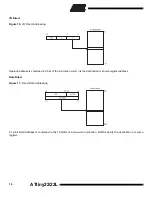
6
ATtiny22/22L
A flexible interrupt module has its control registers in the I/O space with an additional global interrupt enable bit in the status
register. All the different interrupts have a separate interrupt vector in the interrupt vector table at the beginning of the
program memory. The different interrupts have priority in accordance with their interrupt vector position. The lower the
interrupt vector address, the higher the priority.
General Purpose Register File
Figure 5 shows the structure of the 32 general purpose registers in the CPU.
Figure 5. AVR
CPU General Purpose Working Registers
All the register operating instructions in the instruction set have direct and single cycle access to all registers. The only
exception is the five constant arithmetic and logic instructions SBCI, SUBI, CPI, ANDI, ORI between a constant and a
register and the LDI instruction for load immediate constant data. These instructions apply to the second half of the regis-
ters in the register file - R16..R31. The general SBC, SUB, CP, AND, OR and all other operations between two registers or
on a single register apply to the entire register file.
As shown in Figure 5, each register is also assigned a data memory address, mapping them directly into the first 32 loca-
tions of the user Data Space. Although the register file is not physically implemented as SRAM locations, this memory
organization provides great flexibility in access of the registers, as the X, Y and Z registers can be set to index any register
in the file.
7
0
Addr.
R0 $00
R1
$01
R2
$02
…
R13
$0D
General
R14
$0E
Purpose
R15
$0F
Working
R16
$10
Registers
R17
$11
…
R26
$1A
X-register low byte
R27
$1B
X-register high byte
R28
$1C
Y-register low byte
R29
$1D
Y-register high byte
R30
$1E
Z-register low byte
R31
$1F
Z-register high byte






































